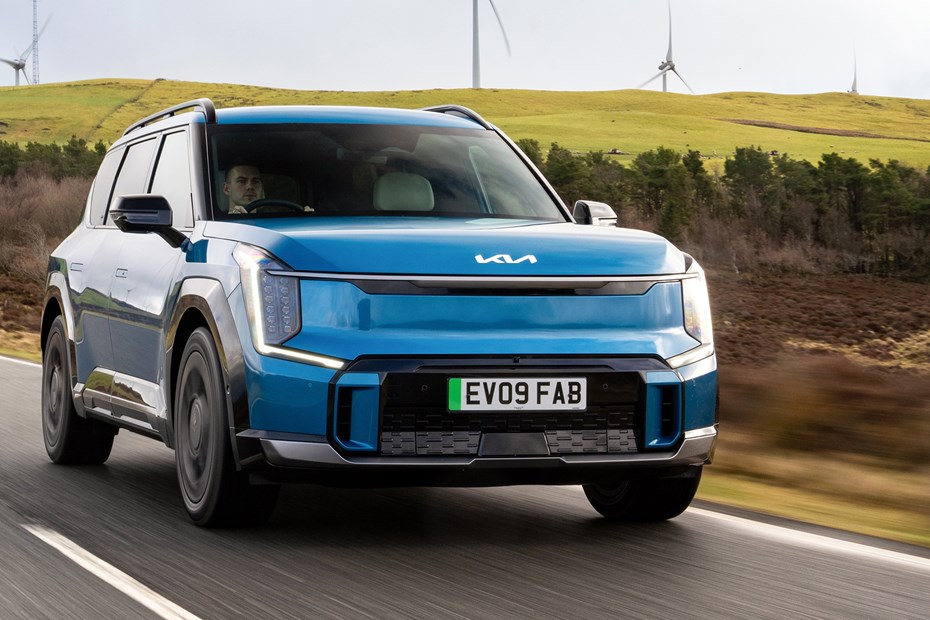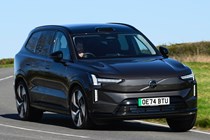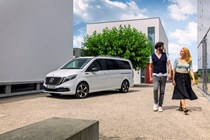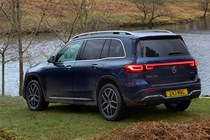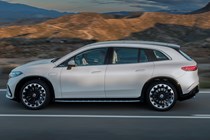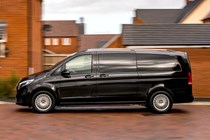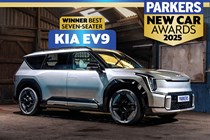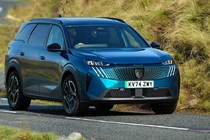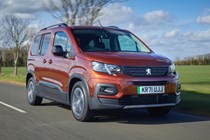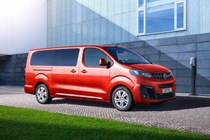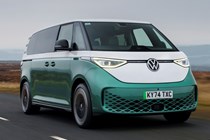A few short years ago, seven-seat cars were enormous boxes on wheels with gigantic, hideously inefficient combustion engines. In 2025, the dimensions of these cars are bigger than ever, but the fuel that powers them has changed. Now, some of the best seven-seaters on sale are powered by electricity.
SUVs still dominate the sector, but several van-based seven-seat electric people carriers have crept into our top 10, lapping up places on the leaderboard while slower-moving manufacturers are still grappling with the affordability of their electric car technology.
Range is becoming less of a concern, too. The best options on this list can cover 300 miles in the real world, which is far longer than we’d recommend driving in one stint. Plus, because charging tech is improving, some of the cars here can claw back hundreds of miles of range in the time it takes for you to stop for a coffee and a stretch.
Scroll down to browse our pick of the electric seven-seater market. We’ve got a summary of each of our favourites below, along with a link to our detailed main reviews should you wish to learn more.
The best seven-seater electric cars
Our favourite electric seven-seater
Being a Kia EV, the charging time is one of the quickest out there, although efficiency isn't quite as impressive as its lower, lighter siblings. Six and seven-seat versions are available with rear- or four-wheel drive.
To find out more, read our full Kia EV9 review
Pros
- Spacious, even in the third row
- Rapid charge times
- Tidy handling
Cons
- Unsettled ride
- Efficiency not the best
Hyundai Ioniq 9
It’s a close second place for Hyundai
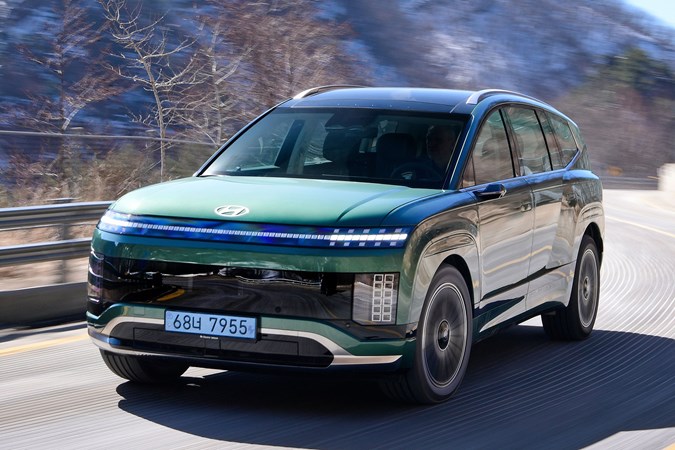

Hyundai has tried to make the Ioniq 9 a little more luxurious than the EV9, which makes the car more of a natural rival for the Range Rover. For example, its suspension has been tuned to iron out more imperfections at speed, there’s even less road noise than the Kia and you can have it with some hilariously opulent white leather reclining rear seats.
We’ll have to withhold our final judgement until we’ve driven the car on UK roads, but the early signs are promising. We’ll update you with more information as soon as it touches down on our shores.
To find our more, read our full Hyundai Ioniq 9 review
Pros
- Practical interior
- Smooth to drive
- Good range
Cons
- Fiddly infotainment
- Brakes feel quite weak
The coolest electric seven-seater money can buy
The Buzz’s maximum range is limited by its heavy weight and blunt shape. That means it can’t drive as far on a charge as a conventionally-shaped Volkswagen MEB electric car, such as an ID.4 SUV or Skoda Enyaq. If you only need a car with five seats and can live without the Buzz’s cavernous boot space, these will be more convenient to own. It's also proving to be something of a bargain on finance these days, too.
To find out more, read the full Volkswagen ID.Buzz review
Pros
- Doesn’t feel like a van to drive
- Desirable looks, attractive cabin
- Reasonable electric range
Cons
- Poor touch-led interior controls
- Sporty GTX feels rather pointless
Upmarket SUV blends ease of use with style and practicality
In terms of seating it’s probably best to think of it as a 5+2 rather than a full-fat seven seater. Tall adults won’t really fit in the back row, but people below 5ft 4in should have no problem. If you’re in the market for a premium-badged electric SUV with seating for seven and four-wheel drive, not much can touch it.
To find out more, read our full Mercedes-Benz EQB review
Pros
- Stylish looks and practical interior
- Good equipment levels
- Drives well
Cons
- Tesla Model Y offers a longer range
- Third row is cramped
Boxy E-Rifter majors on practicality and flexibility
The limited range makes this more of a grocery-getter than a long-distance cruiser, but that’s where the Rifter excels. It’s nippy off the line thanks to the electric powertrain and the soft suspension does a good job of cocooning you from potholes normally found in towns.
To find out more, read our full Peugeot E-Rifter review
Pros
- Clever use of space
- Pleasant ride and handling
- Lots of kit as standard
Cons
- Small electric range
- Looks like a van
The most luxurious people carrier of them all
At speed it really wafts along. You feel wonderfully insulated from the road beneath you. The Hyperscreen is a must for tech heads and the electric range looks to be spot on. Even when compared with other electric SUVs, it is expensive, and the brake feel is inconsistent. But as a car that (just about) drives itself, this really does fit the bill.
To find out more, read the full Mercedes-Benz EQS SUV review
Pros
- Amazing long-distance prowess
- Large battery means long range
- Cavernous interior
Cons
- Hugely expensive
- Some quality issues
It's expensive, but quite luxurious
Volvo has done a good job of designing the EX90’s packaging and platform. It’s a practical beast with enough room in the first two seating rows to house five adult passengers. Quality is good overall, refinement is excellent, it supports 250kW DC rapid charging and, if you splash out on the top-spec Performance model, it’s immensely fast.
It’s not without its problems, however. The biggest issue is Volvo’s obsession with ditching physical cabin controls. Now everything is housed on the infotainment screen – and it’s rather distracting when you’re on the road. We weren’t impressed by its efficiency, either. A real-world range of 290 miles for a car with a 107kWh battery pack isn’t good enough.
To find out more, read our full Volvo EX90 review
Pros
- Comfortable ride
- Whisper quiet inside
- Flexible seating
Cons
- Annoying touchscreen
- EV9 is better for less
Stylish and roomy enough for large families
Prices start from less than £280 per month, which is far more attractive than the £400 per month Mercedes EQB, the £500 per month Kia EV9 or the £600 per month Volkswagen ID. Buzz. Look beyond the criteria of 'cheap' and 'EV' and it has a slightly tougher time, however – the Skoda Kodiaq is an ever-impressive and infinitely more recommendable car for the money.
To find out more, read the full Peugeot E-5008 review
Pros
- Seats seven in style
- Strong interior quality
- A mostly effortless drive
Cons
- It’s a heavy car
- Ride can feel firm
A practical people carrier, albeit one with limited range
Inside it’s truly cavernous. The Vivaro Life Electric battery pack is located under the floor, which means there’s no impact on space for passengers or luggage, just the same as the diesel version. But where the diesel engine is gruff, the electric Vivaro serenely glides through traffic. Sure, it’s not quick, but who really wants to go at full tilt with all of those seats filled anyway?
To find out more, read our full Vauxhall Vivaro Life Electric review
Pros
- Truly cavernous
- Strong dealer network
- Easy to drive, despite its size
Cons
- Not the most desirable
- Won't go that far
Premium MPV packs a good range and lots of space
In other words, it’s posh. There’s leather, soft-touch plastics and a slew of electrical gubbins to keep everyone happy. Plus there’s the option of air suspension that can make the car’s ride harder or softer depending on your mood. The biggest downside is the price. It’s pretty much double the money of the Vivaro Life electric, and although it’s palpably posher, it’s not really that much more practical.
To find out more, read our full Mercedes-Benz EQV review
Pros
- Good range
- Massive
- Luxurious
Cons
- Expensive
- Too posh for kids' mess?
FAQs: Seven-seat electric cars
-
What is the largest electric car with seven seats?
That depends on how you strictly you apply the word ‘car’ in that question. If you want the biggest car-shaped electric car with seven seats, you’ll be shopping for a Hyundai Ioniq 9. That measure a whopping 5.07 metres long and almost two metres wide.
However, you can get an even bigger seven-seat electric vehicle if you don’t mind it looking like a van. The Mercedes EQV is 5.14 metres long, while the Volkswagen ID. Buzz LWB is just shy of five metres long – yet both feel roomier than the Ioniq 9 inside as neither have long bonnets. That means more of their platform is dedicated to passenger space. -
What is the price of an EV 7-seater?
That depends. The prices of the electric seven-seaters in this list vary from around £30,000 for the Peugeot e-Rifter to upwards of £100,000 for the flagship version of the Volvo EX90. We recommend you aim for the middle and opt for the Kia EV9 as it has a more reasonable starting price of around £65,000.
-
Is there an electric car with a 3rd row?
This list shows there are plenty. Before you buy, though, you should first nail down how often you’re likely to use that third row, as that’ll inform what sort of vehicle you should purchase. If you’re only going to use the rearmost seats infrequently, the Kia EV9 should be perfect for your purposes. There’s just enough space back there to get comfortable – but they’re a little difficult to access and we found we get cramped up on longer journeys.
If you’re going to be using the 3rd row of seats constantly, you might be better off with the Volkswagen ID. Buzz LWB. Go for the six-seat model and you simply walk down the aisle between the second row of seats to access them.
Just so you know, we may receive a commission or other compensation from the links on this website - read why you should trust us.


